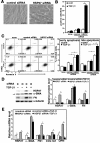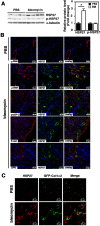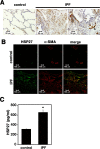Heat Shock Protein 27 Plays a Pivotal Role in Myofibroblast Differentiation and in the Development of Bleomycin-Induced Pulmonary Fibrosis
- PMID: 26859835
- PMCID: PMC4747463
- DOI: 10.1371/journal.pone.0148998
Heat Shock Protein 27 Plays a Pivotal Role in Myofibroblast Differentiation and in the Development of Bleomycin-Induced Pulmonary Fibrosis
Abstract
Heat shock protein 27 (HSP27) is a member of the small molecular weight HSP family. Upon treatment with transforming growth factor β1 (TGF-β1), we observed upregulation of HSP27 along with that of α-smooth muscle actin (α-SMA), a marker of myofibroblast differentiation, in cultured human and mouse lung fibroblasts. Furthermore, by using siRNA knockdown, we demonstrated that HSP27 was involved in cell survival and upregulation of fibronectin, osteopontin (OPN) and type 1 collagen, all functional markers of myofibroblast differentiation, in TGF-β1-treated MRC-5 cells. In lung tissues of bleomycin-treated mice, HSP27 was strongly upregulated and substantially co-localized with α-SMA, OPN and type I collagen but not with proSP-C (a marker of type II alveolar epithelial cells), E-cadherin (a marker of epithelial cells) or F4/80 (a marker of macrophages). A similar co-localization of HSP27 and α-SMA was observed in lung tissues of patients with idiopathic pulmonary fibrosis. Furthermore, airway delivery of HSP27 siRNA effectively suppressed bleomycin-induced pulmonary fibrosis in mice. Collectively, our findings indicate that HSP27 is critically involved in myofibroblast differentiation of lung fibroblasts and may be a promising therapeutic target for lung fibrotic diseases.
Conflict of interest statement
Figures





Similar articles
-
Detection of epithelial to mesenchymal transition in airways of a bleomycin induced pulmonary fibrosis model derived from an alpha-smooth muscle actin-Cre transgenic mouse.Respir Res. 2007 Jan 7;8(1):1. doi: 10.1186/1465-9921-8-1. Respir Res. 2007. PMID: 17207287 Free PMC article.
-
Negative regulation of myofibroblast differentiation by PTEN (Phosphatase and Tensin Homolog Deleted on chromosome 10).Am J Respir Crit Care Med. 2006 Jan 1;173(1):112-21. doi: 10.1164/rccm.200507-1058OC. Epub 2005 Sep 22. Am J Respir Crit Care Med. 2006. PMID: 16179636 Free PMC article.
-
Emodin alleviates bleomycin-induced pulmonary fibrosis in rats.Toxicol Lett. 2016 Nov 16;262:161-172. doi: 10.1016/j.toxlet.2016.10.004. Epub 2016 Oct 4. Toxicol Lett. 2016. PMID: 27717887
-
[HSP27: A new target for treating idiopathic pulmonary fibrosis?].Rev Mal Respir. 2020 Mar;37(3):210-213. doi: 10.1016/j.rmr.2020.02.007. Epub 2020 Mar 4. Rev Mal Respir. 2020. PMID: 32146056 Review. French.
-
Cellular players in lung fibrosis.Curr Pharm Des. 2012;18(27):4093-102. doi: 10.2174/138161212802430396. Curr Pharm Des. 2012. PMID: 22630084 Review.
Cited by
-
Targeting CK2 mediated signaling to impair/tackle SARS-CoV-2 infection: a computational biology approach.Mol Med. 2021 Dec 20;27(1):161. doi: 10.1186/s10020-021-00424-x. Mol Med. 2021. PMID: 34930105 Free PMC article.
-
Mesenchymal MAPKAPK2/HSP27 drives intestinal carcinogenesis.Proc Natl Acad Sci U S A. 2018 Jun 12;115(24):E5546-E5555. doi: 10.1073/pnas.1805683115. Epub 2018 May 29. Proc Natl Acad Sci U S A. 2018. PMID: 29844172 Free PMC article.
-
Therapeutic Potential and Mechanisms of Rosmarinic Acid and the Extracts of Lamiaceae Plants for the Treatment of Fibrosis of Various Organs.Antioxidants (Basel). 2024 Jan 24;13(2):146. doi: 10.3390/antiox13020146. Antioxidants (Basel). 2024. PMID: 38397744 Free PMC article. Review.
-
Heat shock protein 27 promotes cell cycle progression by down-regulating E2F transcription factor 4 and retinoblastoma family protein p130.J Biol Chem. 2018 Oct 12;293(41):15815-15826. doi: 10.1074/jbc.RA118.003310. Epub 2018 Aug 30. J Biol Chem. 2018. PMID: 30166342 Free PMC article.
-
Drug like HSP27 cross linkers with chromenone structure ameliorates pulmonary fibrosis.Front Pharmacol. 2023 Jul 4;14:1203033. doi: 10.3389/fphar.2023.1203033. eCollection 2023. Front Pharmacol. 2023. PMID: 37469871 Free PMC article.
References
-
- Selman M, King TE, Pardo A. Idiopathic pulmonary fibrosis: prevailing and evolving hypotheses about its pathogenesis and implications for therapy. Ann Intern Med. 2001; 134(2):136–151. . - PubMed
-
- Honda E, Park AM, Yoshida K, Tabuchi M, Munakata H. Myofibroblasts: Biochemical and proteomic approaches to fibrosis. Tohoku J Exp Med. 2013; 230(2):67–73. . - PubMed
Publication types
MeSH terms
Substances
LinkOut - more resources
Full Text Sources
Other Literature Sources
Medical
Research Materials
Miscellaneous

